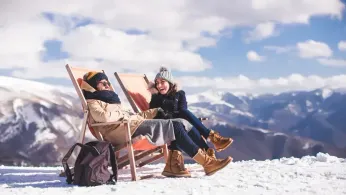
Oct 16
Winter Pride Festivals: How LGBTQ+ Ski Weeks Are Transforming Winter Sports
Andrea Marks Joseph READ TIME: 3 MIN.
A Growing Winter Tradition
As winter settles across the Northern and Southern Hemispheres, a new tradition is taking root in the LGBTQ+ community: winter pride festivals. What began as small gatherings at a handful of ski resorts has blossomed into a global movement, with major events in Europe, North America, and Australasia. From the Arosa Gay Ski Week in Switzerland to Winter Pride Queenstown in New Zealand, these festivals not only celebrate LGBTQ+ visibility but also challenge the historically exclusive culture of winter sports .
Key Events and Their Impact
Among the most prominent gatherings is the Arosa Gay Ski Week, held each January in the Swiss Alps. This event attracts over 600 LGBTQ+ winter sports fans from more than 30 countries, offering over 220 kilometers of slopes, drag performances, après-ski parties, and cultural programming. Attendees emphasize the sense of safety and community that permeates the resort, where rainbow flags and inclusive messaging transform the landscape into a welcoming space for all sexual orientations and gender identities .
In North America, Aspen Gay Ski Week in Colorado and Winter Rendezvous in Stowe, Vermont, draw thousands each year. Aspen’s event, now in its 49th year, features not only skiing but also drag brunches, pool parties, and advocacy workshops. Organizers note that the week has become a key fundraiser for regional LGBTQ+ nonprofits, blending celebration with activism .
Meanwhile, the Southern Hemisphere’s largest LGBTQ+ winter festival, Winter Pride Queenstown, transforms the New Zealand resort town into a hub of pride parades, dance parties, and mountain sports. In 2025, the festival’s lineup included over 24 parties, eight on-mountain days, and a diverse range of events such as cabaret, quiz nights, and a boat party. Local businesses and residents join in, making the entire community part of the celebration .
Why Winter Pride Matters
Participants and organizers alike stress that winter pride festivals do much more than provide entertainment. For many, these events are about visibility, representation, and the right to occupy spaces—such as ski resorts—that have not always felt safe or inclusive to LGBTQ+ people. Representation in sports, especially those traditionally perceived as elite or exclusive, remains an ongoing challenge. The presence of LGBTQ+ Olympians like Gus Kenworthy at such festivals underscores the power of visibility and the importance of creating welcoming environments for all .
For transgender people and other gender-diverse attendees, the affirming atmosphere and careful attention to inclusivity are vital. Organizers of Winter Pride Queenstown and European Snow Pride in France have implemented explicit policies supporting gender diversity, including non-gendered restrooms, pronoun badges, and all-gender competition categories .
Community, Safety, and Economic Impact
The impact of winter pride festivals extends beyond the LGBTQ+ community. Host cities and resorts often see significant economic benefits, with thousands of visitors booking hotels, restaurants, and activities. For example, Winter PrideFest in Central Oregon grew from 150 participants in 2018 to over 2,400 attendees in 2025, boosting local tourism during a typically quiet season .
Safety and inclusivity are always top priorities. Event organizers collaborate with local authorities, hospitality providers, and community partners to ensure that all attendees—regardless of their gender identity or sexual orientation—feel protected and respected. This collaborative approach has led to the development of best practices, such as visible security, anti-harassment policies, and accessible facilities for people with disabilities .
Looking Ahead: The Future of LGBTQ+ Winter Sports
With new events emerging each year—from Rainbow Mountain in Australia to Telluride Gay Ski Week in Colorado—the reach and influence of winter pride festivals continue to expand. Organizers are exploring ways to make these gatherings even more accessible, including scholarships for underrepresented groups, partnerships with advocacy organizations, and expanded programming for families and allies .
As winter pride festivals gain visibility, they send a clear message: LGBTQ+ people belong in every season, on every mountain, and in every community. By carving out space on the slopes and in the heart of winter, these events are helping to build a more inclusive world—one celebration at a time.






